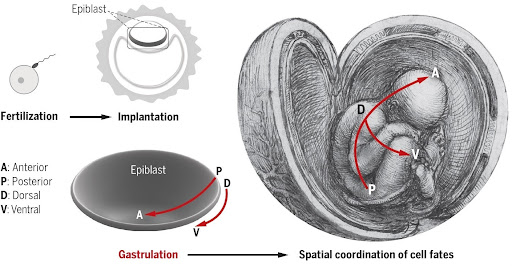A new perspective of the key moments of embryonic development
Alfonso Martínez Arias, head of the Stembryo Engineering Lab at UPF, participates in a review published in Science in which the authors offer offer a new perspective of the role of a structure in embryonic development known as the primitive streak.

In a review published in the journal Science, the researchers Guojun Sheng (Kumamoto University, Japan), Alfonso Martínez Arias (UPF) and Ann Sutherland (University of Virginia Health System, USA) offer a new perspective of the role of a structure in embryonic development known as the primitive streak. The primitive streak was established as the first sign of the human being during development and therefore current regulations in many countries do not allow embryos to be grown beyond its appearance, 14 days after fertilization.
In the present study, the scientists perform a synthesis of what is known about this structure including recent studies on models of embryonic processes based on stem cells. The authors conclude that the primitive streak is not necessary for the organization of the embryo. They suggest, therefore, that the choice of the appearance of this structure as the first indication of the human being, the “14-day rule”, is arbitrary. Recently, technical advances have recommended a review of this rule to allow experimenting with embryos beyond day 14; this work provides scientific arguments to support such a change.
The primitive streak was established as the first sign of the human being during development and therefore current regulations in many countries do not allow embryos to be grown beyond its appearance, 14 days after fertilization.
A human being starts from the fertilized egg that splits successively to form a mass of cells. A week after fertilization it implants into the uterus and seven days later gastrulation begins. This process transforms what is a mass of cells into a structure where an outline of the organism can be recognized, with the head at one end and the structures that will give rise to the organs and tissues perfectly positioned in their right places. The recently deceased biologist Lewis Wolpert coined the famous adage that the most important moment of our lives is not birth, marriage or death, but gastrulation. The primitive streak is an iconic structure of gastrulation that exists in all mammals, reptiles and birds.
Implications of the primitive streak in early embryogenesis models
Experimentation with human embryos derived from in vitro fertilization and similar structures with stem cells is highly regulated. It is possible in the laboratory to grow human pluripotent cells before gastrulation and by adding biochemical signals, guide them to differentiate into different cells. However, their culture in functional tissues or organs has rarely been successful because the organ-forming process begins immediately after gastrulation. Reproducing rudimentary organs in vitro is the holy grail in research into stem cell biology and regenerative medicine, but achieving it would require reproducing gastrulation and its associated primitive streak.
Their arguments support that 14th day rule, which was put forward in the 1980s as a response to the possibilities derived from the cultivation of human embryos for in vitro fertilization based on the knowledge of the time, should be reassessed.
Through a systematic review of previous research, the team of scientists has evaluated the relationship between the primitive streak and the appearance of a human being from the current perspective and, in particular, from studies with stem cells. Their analyses of different biomechanical parameters among multiple in vivo and in vitro models predict that a rudimentary mammalian body plan can be formed in the absence of a primitive streak. “We conclude that the primitive streak is not absolutely necessary to make an outline of the organism”, Alfonso Martínez Arias, ICREA research professor and head of the Stembryo Engineering Lab, explains.
“Hence our arguments support that 14th day rule, which was put forward in the 1980s as a response to the possibilities derived from the cultivation of human embryos for in vitro fertilization based on the knowledge of the time, should be reassessed. Of course, this line of reasoning does not discuss the need for ethical oversight in human-related developmental and stem cell biology research, but we propose selecting an alternative landmark through a consensual discussion to ensure scientific and ethical rigour”.
Reference article:
The primitive streak and cellular principles of building an amniote body through gastrulation. DOI: 10.1126/science.abg1727.
